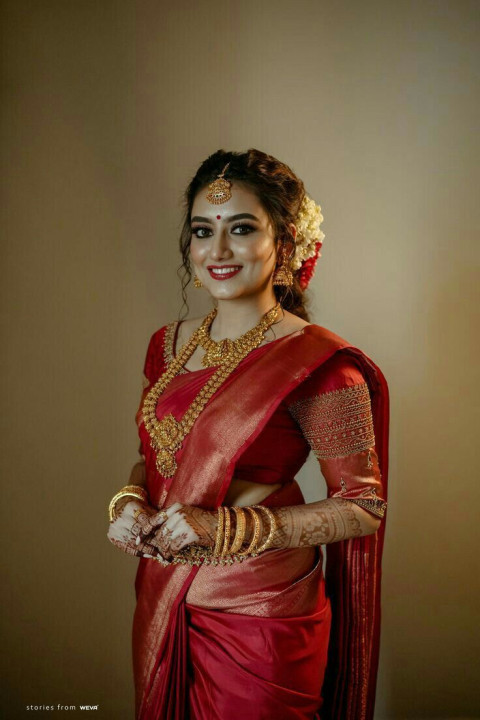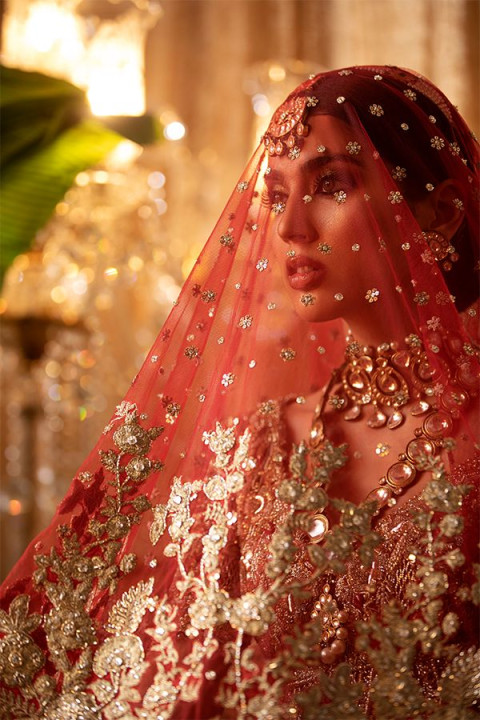
Indian wedding attire is known for its vibrant colours, intricate designs, and cultural significance. Each region in India has its own unique styles and traditional clothing, reflecting the diversity of the country. Generally Brides in Indian culture frequently wear pink or red wedding lehengas or sarees. These lehengas or sarees are heavily embroidered with Zari work. In addition, the Indian brides adorn beautiful gold jewellery from top to bottom. Grooms wear Sherwani or Dhotis in either matching or contrasting hues to the bride’s outfit.
South Indians Wedding Attire:
South Indian weddings are made typical of their native beliefs, most commonly performed at a temple. The bride wears a heavy silk Kanjivaram saree, with loads of gold jewellery. The gold ornaments are taken to be very auspicious among South Indians. Amongst their jewellery one will find elaborate Maang Tikas that line the forehead and run down the parting of the hair, along with the Sun and the Moon hair ornaments on either sides of the parting. They also wear a Cummerbund at the waist (also made of gold) and usually a Bajubund (arm bracelet), and gold anklets or Payals. The hair is worn in a long plait, spruced up with flowers and decorative plait ornaments.

Rajasthani Wedding attire:
Rajasthani brides dress in elaborate ghagra cholis covered with zari embroidery. They also have a sizable jewellery collection. Rajasthani bridal jewellery included nose rings, armlets, meenabutti, haathphool, and maang tikka. They also have on chudha and kundan rings. Bangles made of gold and ivory are also significant components of Rajasthani wedding jewelry. Recall the Jodha Akbar movie?

Punjabi wedding attire:
Punjabi brides typically dress in a matching Odhna to cover their hair and a Patiala Salwar Kameez covered in a tonne of sequins and beads. Wearing the Patiala salwar with a fitting kurta or kameez that is knee-length (or shorter) is a stylish way to showcase its numerous pleats and loose fit, which contrasts with the normal salwar. Punjabi dulhans are known for wearing necklaces, earrings, and Maang Tika, in addition to Chudas, a pair of 21 ceremonial red and ivory bangles worn on each arm, and ceremonial charms called Kaliras, which are traditional gold, silver, or gold-plated trinkets, tied to one of the bangles. After the wedding, the Kalira charms are supposed to fall on the heads of single girls, and whoever they land on is said to be next in line to get married. The women often tie their hair in long braids with a fancy Paranda at the end.

Maharastrian Wedding Attire:
Marathi brides have a distinct makeup style that sets them apart from other traditional Indian brides. They don a piece of unisex jewelry known as Mundavalya. The groom wears it as well. Essentially, this is a horizontally knotted string of pearls across the brow. Maharashtra brides also wear green glass bangles, which stand for growth and fertility. Another significant gem is their nose ring, which is fashioned of Basra pearl.

Himachali Bride:
The people of Himachal are Brahmins and Rajputs. Traditionally, they dress in long kurtas, salwars, cholis, and Ghaghras. Simple makeup and striking jewellery, such as Maang Tika and enormous Nathni, or nose ring, which are both distinctive Himachali mountain jewels, complete their ensemble.
